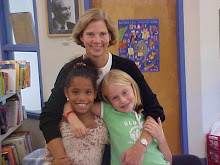We've had a beautiful fall. The colors, the warm days, the light filtering through the red and orange leaves...
This morning I wished a sunny day to one of our parents and he said that since his job is in a basement, he can't see the sun. I feel so sad for him! It is so wonderful to work in a light-filled space with the sun streaming in my windows.
Being outside in the light is a freedom and privilege that we try to maximize at school - especially since we are the beneficiaries of a 77 acre outdoor classroom. We recognize that kids' day is ruled by adults so much of the time, so committing to get them outdoors for an hour or two a day is a priority.
We are doing a construction project right now that has put the play structure for grades K - 8 off limits and we have moved recess to the field and woods. It is definitely fun - but as in many ventures with children, needs regular adjustments.
Here is part of an email that one teacher sent around over the weekend asking others to join in a meeting with the K - 5 children. (When you read this, you will see why I truly love my job!)
With forts, there are lots of concerns about exclusion (kids telling others they aren't allowed in their fort, cloaked in "there's no room"), kids "stealing" things or "destroying" the forts of others when unoccupied, which has led to guards, and plots to attack. My guys also complained that there were secret passwords and security guards who kept people out. I wouldn't say my kids are up in arms, but there's a lot of uncertainty and hard feelings in the works. As for sticks, I heard they are still being used as weapons and a bunch of my kids said that sword fighting is happening when the adults aren't looking. I did feel the other day that the consent given to use sticks for digging has become a definite loop hole.
So, there was a meeting this morning at 9:00 and the kids and teachers came up with some new guidelines:
Peaceful forts is the rule...sticks can only be used to build forts, not to dig or for weapons...forts can only be destroyed with the consent of all builders...
It was definitely more peaceful today. At recess, I was reminded that kids' natural proclivity is to be very industrious. They were working very hard on forts, a new bridge, a see-saw - and I heard a lot of negotiation and talk to remind each other and themselves about the rules. Sitting down together this morning to work it all out was a crucial process for the peaceful day we had.
I am tempted to take this lesson and apply it to our country's political process, and my optimistic view is that elections, debating among ourselves and voting are the ways we set and reset our rules in pursuit of industriousness and fairness. I think "peaceful forts" is a pretty good rule.














